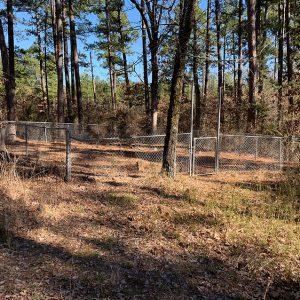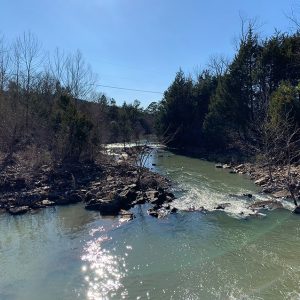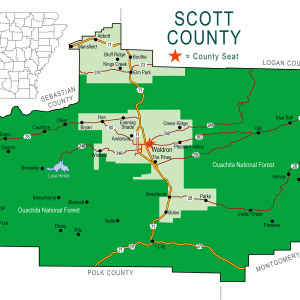calsfoundation@cals.org
Colburn Spring (Scott County)
Colburn Spring is a historical community located in northeastern Scott County. The community was established south of the Petit Jean River near the Cedar Creek tributary in what is now the Ouachita National Forest. Agriculture and mining contributed significantly to the way of life in Colburn Spring.
Prior to European exploration, the area surrounding Colburn Spring was a wilderness. Several species of wildlife that no longer inhabit the area, such as elk and buffalo, were present throughout the region. Numerous archaeological sites and burial mounds can be found along the banks of prominent waterways such as the Petit Jean River. Archaeological findings have provided evidence of early inhabitants dating to the Archaic, Woodland, and Mississippian periods. Further archaeological evidence has indicated that the people of the Caddo tribe later inhabited the area.
During the late seventeenth and early eighteenth centuries, French hunters and tradesmen traveled west from the Arkansas Post, exploring portions of western Arkansas. These Frenchmen often traversed rivers and streams throughout the region. Several rivers that flow through Scott County were likely named by these explorers, including the Petit Jean, Poteau, and Fourche La Fave.
Settlers began arriving in the area surrounding Colburn Spring during the late 1830s and early 1840s. The area was continually settled through the early twentieth century. Settlers participated in a wide variety of agricultural practices.
Men called to fight in the Civil War served with both the Confederacy and Union. The women and elderly were left to look after family homes and farms. Instances of bushwhacking occurred in the area during the war.
During Reconstruction, many settlers traveled west to Arkansas from war-torn regions of the South in order to start a new life. Several people during this time began settling directly in what would become Colburn Spring.
The community continued to grow after Reconstruction. After the Civil War, the Coburn family traveled from Mississippi to Montague County, Texas, in 1880. Sometime between 1885 and 1889, Leroy M. Coburn traveled to Scott County with wife Susan, son Andrew J. Coburn, daughter-in-law A. Eliza Coburn, and several grandchildren. Leroy Coburn served for two years as a private in the Fifth Arkansas Infantry Regiment, Company K, for the Confederate States of America during the Civil War. He enlisted on June 13, 1861, at Wittsburg (Cross County) and was considered absent without leave (AWOL) in August 1862, though this was likely because he was moved to Company F, Seventh Regiment Mississippi Cavalry, where he served as a lieutenant. (As a side note, Coburn’s pension lists him as serving in the Eleventh Mississippi Cavalry in Company H, and his headstone lists him as serving in Company H in Arkansas and Company K in Mississippi.) Coburn served with the Mississippi regiment until the end of the war.
Within the community is a spring that served as a swimming hole and location to gather water. A cemetery was also established in the community at some point. The cemetery, spring, and community were likely named for the Coburn family. At some point the letter “L” was added to the name, making it “Colburn,” possibly due to mispronunciation or misspelling by locals. A second cemetery, called Thompson Cemetery, is located just north of Colburn Spring. The oldest grave marker in the cemetery dates to 1891, but the cemetery was likely established earlier.
Mining was a short-lived industry in the area, but it likely contributed to the economy in Colburn Spring. A gold mine was located in the vicinity of Colburn Spring for a short time but was closed after it became clear that there was not enough gold to support an operating mine.
The community eventually declined due to the absence of schools, a post office, or industry.
In the twenty-first century, the remnants of the community are located within the Ouachita National Forest. The remains of several homesteads can be found throughout the National Forest and on some areas of private property. Likewise, there are numerous stone walls that were once used by farmers throughout the area. Hunting and fishing are popular recreational activities in the area.
For additional information:
Biographical and Historical Memoirs of Western Arkansas. Chicago: Goodspeed Publishing Company, 1891.
Cate, Michael. History of Scott County, Arkansas. Dallas, TX: Curtis Media Corporation, 1991.
Goodner, Norman. A History of Scott County, Arkansas. Siloam Springs, AR: Bar D Press, 1941.
McCutcheon, Henry Grady. History of Scott County, Arkansas. Little Rock: H. G. Pugh and Company, 1922.
Ty Richardson
Richardson Preservation Consulting
 Agricultural Wall
Agricultural Wall  Colburn Cemetery
Colburn Cemetery  Petit Jean River
Petit Jean River  Scott County Map
Scott County Map 



Comments
No comments on this entry yet.